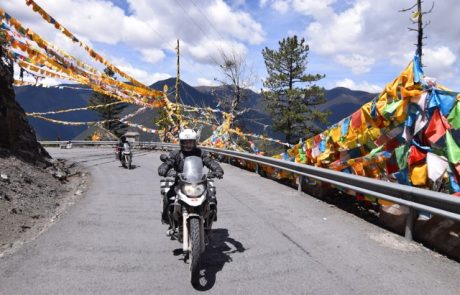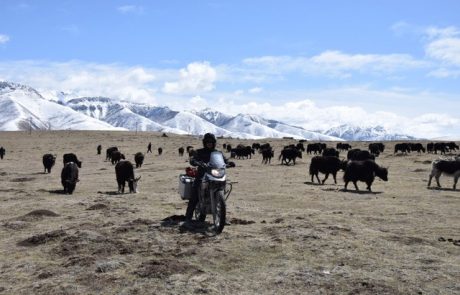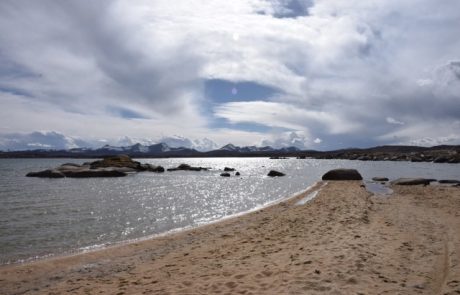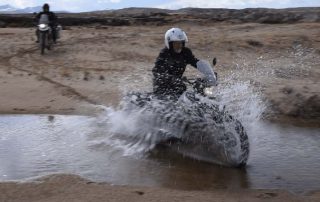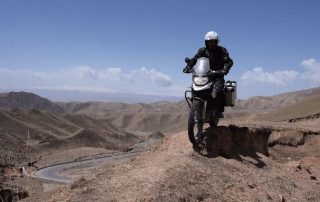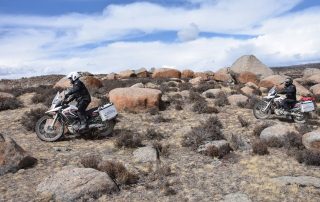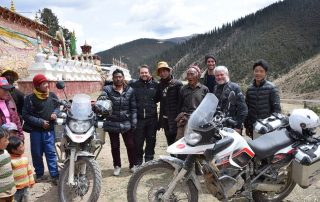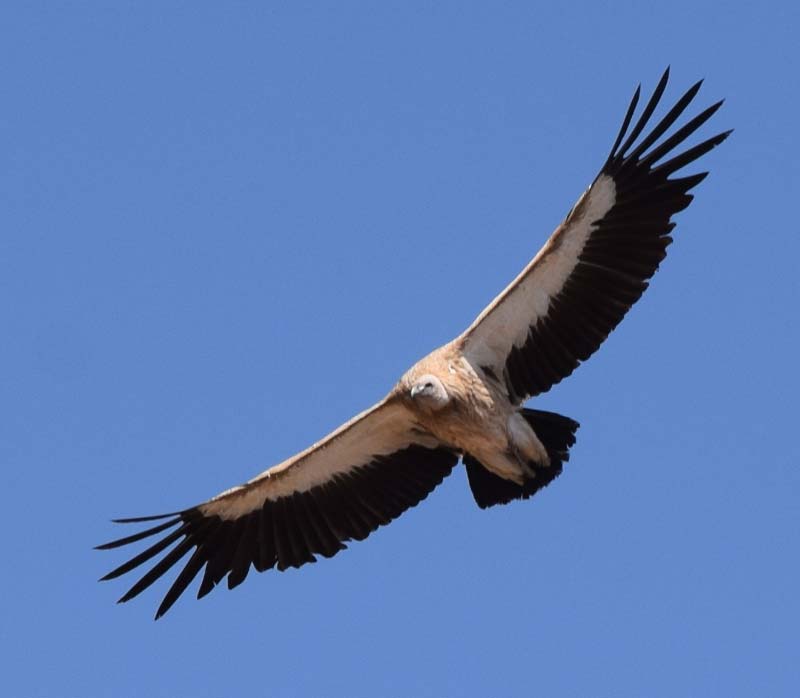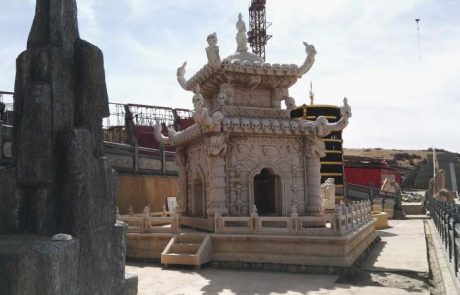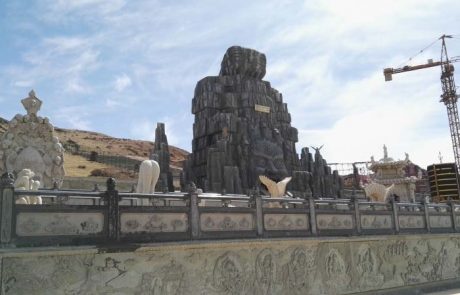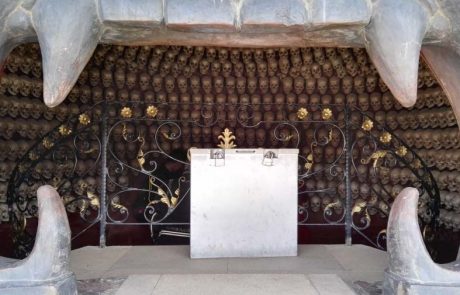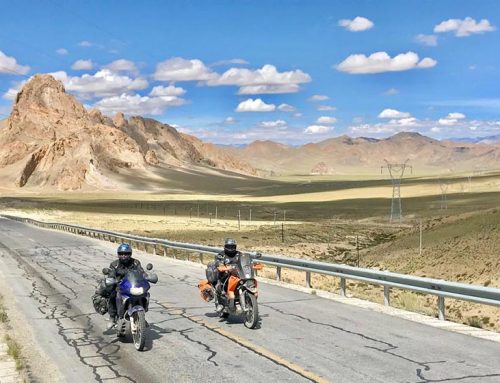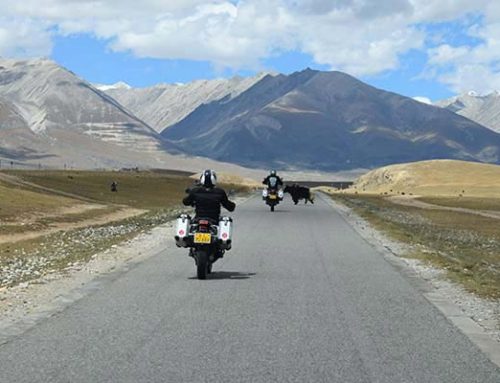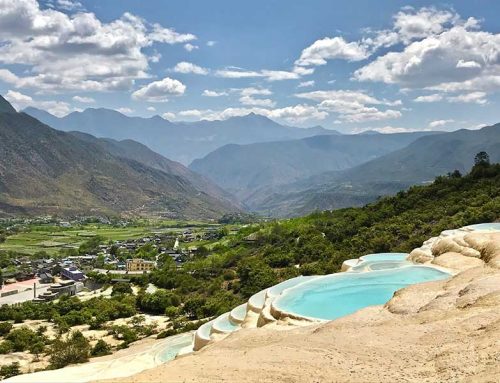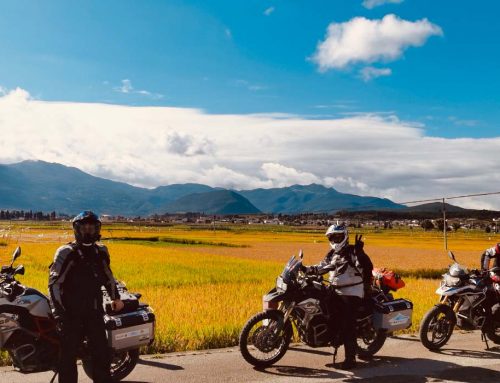On the Road to the Monastic City of Seda
The Tibetmoto Team explores new paths in Sichuan and Qinghai
China is big, and there are many roads that are begging to be explored. On this scouting tour, we will plan a new tour with the MOTORRAD action team. This tour is supposed to be a trip full of superlatives. The idea is to do a motorbike tour along the borders of Tibet. We want to explore the central Asian, eastern Tibetan Qinghai., scouting the road conditions and hotels and working out the most exciting route.
Qinghai is far from the China that the world knows for its big cities. It is a province in the eastern Himalayas on the Tibetan high plateau. To get there on a motorbike is a long trip, so we put our two Shineray X5 400 motorbikes on the bed of the pickup and took the expressway to Shangri-la.
When we arrive, the weather is not so good. It is cold and damp, not exactly the best conditions for a trip into the northern, high-altitude Qinghai. We sit in front of the fireplace in Shangri-la and let our thoughts travel to Southeast Asia. Wouldn’t it be nicer to explore the jungles of Laos and ride to the tropical seas off Cambodia?
But the North is calling and the following day, at least, is dry. Behind Shangri-la is a fork in the road, and here is where the road to Sichuan starts. And here we begin our motorbike adventure through China’s unexplored regions.
We unload the motorbikes quickly, and before we know it, we are on a road that, unfortunately, is a paradise of potholes. How are we ever going to get to far-away Qinghai? While the bike riders practice the high art of pothole slalom, it is harder for the pickup with two wheel paths, less suspension travel, and lower wheel clearance. We succeed in finding a balance between the wheels and choose the path of least bumpiness with skill. It is fun, but we still feel glad when we get asphalt under our wheels again.
Daylight is already fading when we take a break in a small village. There is some colourful activity on the street, where the men are playing billiards. We still have 50 km to go before we reach the day’s destination.Suddenly, a scruffy figure appears out of nowhere, sitting on the pickup bed! We already knew from earlier expeditions that the Tibetans are wild people, but this one was acting like a crazy man. Screaming, he clings to our baggage. The villagers nearby do not want to help. Their only contribution is to recommend that we hit the crazy man. That would get him to leave, they said. Together, using all our strength, and without hitting him, we succeed in getting the unwanted hitchhiker off the pickup bed. We then fled the village as fast as possible. However, the vagabond had already started taking care of some other important things and ran off without any shoes.
Passes blocked by snow and the beaches of the Haize lake area
We spend the night in a rustic Tibetan town and eat dinner in a pleasant (and, above all, warm) restaurant. The reason we chose this restaurant? Outside of it was a sign: Good restaurant run by good-looking Chongqing girls. Who could say no to that?
The following morning, we cross the province border to Sichuan. Waiting for us is a 4700 metre pass that we must get over before we can reach the Tibetan high plateau. This bleak landscape presents a barren, white and brown appearance to us: hostile and attractive at the same time so that we don’t know whether we are welcome or whether we should stay away. The viewer’s breast, otherwise breathing with difficulty in the thin air, swells nobly at the sight.
After 4000 bends in the road, we are over the pass and are now at an altitude of 4000 metres, an altitude that we will not be leaving any time soon.
A barren valley tapered under our spinning wheels, and the sun shows us the way to the bizarre Haize lake area. We sun ourselves on a beach; there are steep, snowy mountains in the background, and the water is only slightly above the freezing point.
The water and the sand are inviting us to try them with our off-roaders. It is a battle as the machine roots through the countryside. You can trust the Shineray X5 off roader. We leave this enchanted place and continue our journey, onward down always turning, perfectly paved roads to Litang, a city surrounded by grasslands and snow-covered mountains, where wild dogs hunt like wolves in the streets at night. Litang is the birthplace of the 7th and 10th Dalai Lama.
The journey continues through areas that are, at times, quite remote. Most of the time you do not meet other people on the road. In spite of that, most of the roads are in remarkably good shape, so that David Lengwenus from the MOTORRAD action team said, about this stretch of road: “This is the best stretch of road that I have ever experienced on a motorbike trip in Asia!”
At night, it is raining cats and dogs, and two hundred metres higher up it is snowing. The surrounding mountains shine in the finest white the next morning.
The Seda Academy – The cultural centre of Buddhism
After Litang, we discover a hidden city that turns out to be a good transition to the destination of the next stage of our journey. A rugged canyon opens up and reveals the view of the Seda valley basin. All of the hillsides around the central academy are filled with the ascetic dwelling places of the 20,000 nuns and monks that study in Seda, the biggest Buddhist academy in the world.
We climb a mountain and get tangled up in the Buddhist prayer flags. Huge vultures circle above the valley basin. They are waiting for the next heavenly burial, where the dead are cut into pieces by a monk and fed to the vultures.
The corpses become food for the vultures and are the basis of the vultures’ lives, of their movements; and, in this way, one, fact, finds the dead again in the beat of the wings and the acuteness of vision when a new corpse is made ready for feeding. The circling of vultures, the circle of life. Seda is a special place that does not leave us unchanged. Something else that does not leave us unchanged is the quality of the hotel mattresses. We are awakened, aching, by prayers that echo through the hallway from a screeching microphone.
The heavenly burial of Seda
The heavenly burial in Seda is a remarkable cultural rite. We want to approach the site of the heavenly burial with reverence in our spirits, so as to get a feeling of how the Tibetan culture deals with death. The idea of the dead being cut into pieces and fed to the vultures is a grisly concept for a person from the West. And what we saw was frightening and terrifying. We had imagined almost anything but what we found: that new construction works have turned this pious, holy place into a “Disneyland of Death.”
Around the heavenly burial site, where a vast amount of excrement, indicating the presence of uncounted vultures, and sharpening stones, cleavers and an unmistakeable odor of putrefaction are traces of this ritual–around this place, false stoneworks were being built, great temples of white concrete skulls and skeletons seem to be making fun of death like caricatures. Mixed together in a state of total confusion, statues of weeping angels, naked nymphs, skulls with vampire teeth, trolls, and Aleister Crowley figures, which have nothing to do with Buddhism, decorate this bizarre scene. We felt like we had landed on a set for an Indiana Jones film. They are still building the visitors’ centre.
If these buildings are being financed by the monks themselves rather than by a Chinese investor, then the Western concept of piety certainly is different from the Buddhist one.
We have now been on the road without a break for over a week on our motorbikes in western China. Our daily routine includes many, many hours on the road. The drone of the single-cylinder motors, the rocking movement of the suspension, the remoteness of the grassy steppes and plateau landscapes, the strangeness of the culture– all of this has made an impression and affects us like a meditation practice.Now we can understand these mystical Buddhists living in this land somewhat better.
Have we always been travelling, without pause? The motorbike seems to have become part of us, an extension of our arms and legs. And our spirits embrace the originality, the genuineness of the great country.

